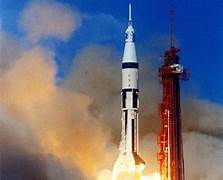On October 11, 1968, a historic event took place in the United States that marked a significant milestone in the Apollo space program. It was on this day that the Apollo 7 mission was launched, becoming the first crewed mission of the Apollo program to orbit the Earth. The Apollo 7 mission was a crucial step towards achieving the ultimate goal of landing humans on the moon. It aimed to test the command and service module (CSM) in Earth orbit, evaluate the crew's performance, and demonstrate the overall feasibility and safety of crewed spaceflight. The crew of Apollo 7 consisted of three astronauts: Commander Walter M. Schirra Jr., Command Module Pilot Donn F. Eisele, and Lunar Module Pilot R. Walter Cunningham. They were launched into space aboard a Saturn IB rocket from the Kennedy Space Center in Florida. During the mission, the Apollo 7 spacecraft orbited the Earth for a total of 163 orbits over the course of almost 11 days. The crew conducted a wide range of experiments and tests to evaluate the spacecraft's systems, including propulsion, guidance, navigation, and life support. One of the key accomplishments of Apollo 7 was the successful test of the CSM's propulsion system. The crew performed a critical engine burn to change their orbit, demonstrating the capability to maneuver the spacecraft in space. This maneuverability was essential for future missions, including lunar orbit insertion and rendezvous and docking maneuvers. The crew also conducted experiments to study the effects of microgravity on the human body. They experienced weightlessness for an extended period, allowing scientists to collect valuable data on the physiological and psychological responses of astronauts to space travel. This research was crucial in understanding the challenges of long-duration space missions. The mission was not without its challenges. The crew faced a series of technical and personal difficulties during their time in space. They encountered issues with the spacecraft's environmental control system, resulting in high humidity and unpleasant odors inside the cabin. Additionally, the crew members experienced symptoms of space sickness, including nausea and headaches, which affected their performance and well-being. Despite these challenges, the Apollo 7 mission was a resounding success. It demonstrated the ability of astronauts to live and work in space for an extended period, paving the way for future crewed missions. The data and experience gained from Apollo 7 were instrumental in the planning and execution of subsequent Apollo missions, including the historic Apollo 11 moon landing. The successful completion of Apollo 7 boosted the morale and confidence of the American public and the space community. It showed that the United States was making significant progress towards the goal of landing humans on the moon, and it set the stage for the subsequent Apollo missions that would ultimately achieve this historic feat. The Apollo 7 mission was a testament to the dedication, skill, and bravery of the astronauts and the countless engineers, scientists, and technicians who worked tirelessly to make it possible. It represented a significant step forward in human space exploration and laid the foundation for future achievements in the Apollo program. Today, the legacy of Apollo 7 lives on as a symbol of human ingenuity and determination. It serves as a reminder of the extraordinary achievements made during the Apollo era and the profound impact that the space program had on our understanding of the universe and our place in it.
11 Oct, 1968 U.S.A. Apollo 7
